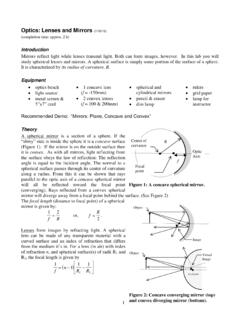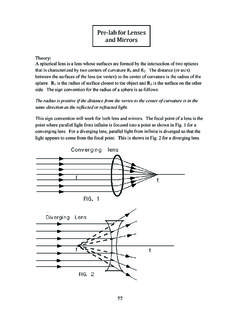Transcription of Mirrors: Handle with Extreme Care
1 mirrors : Handle with Extreme CareTips for the professional on the care and handling of mirrorsThe purpose of this publication is to provide the latest available information to glass dealers,distributors and installers on the procedures recommended by the Mirror Division of the GlassAssociation of North America (GANA) for the proper storage, handling, fabrication, shipping,installation, and cleaning of high quality mirror Mirror Division of GANA has undertaken this project with the objective of helping preservethe integrity and prolonging the life of of this booklet, however, does not promise an end to all mirror problems. Edgedeterioration (black edge) has been reduced due to improvements in mirror coatings. Mostoccurrences are a result of the use of improper cleaning agents. Research into more durablebacking materials, consumer education, and improved mirror manufacturing processes is ongoingin a continuing effort to provide a durable, trouble-free, and environmentally safe , a mirror - because it is a combination of many delicate materials and processes - willnever be indestructible.
2 Proper storage, handling, fabrication and good installation practices go along way in reducing potential failures or damage. Educating consumers in the proper care andcleaning of mirrors requires a continual effort on the part of the entire industry to ensure that themirrors will be properly maintained after they have been publication contains the best information currently available from material suppliers,experienced dealer-installers, and major mirror manufacturers on the care and handling of today squality This document is prepared by the Mirror Division of GANA solely to provideguidance regarding the proper installation and care of mirrors . It represents the collectiveexperience of those in the mirror manufacturing industry; however, this document does notconstitute a standard or specification, either mandatory or voluntary, for the installation and careof mirrors .
3 Conditions and circumstances will vary from installation to installation. It is theresponsibility of the mirror installer to ensure that the installation and care of the mirrors complywith all relevant rules, laws, regulations, applicable standards, and other requirements. GANA disclaims any liability for any loss or damage of any kind arising out of the use of this publication,and all those using it agree, as a condition of use, to release GANA from any and all liability, loss,or damage of any kind or nature arising out of or relating in any way to its use. Users of thispublication understand that GANA is not responsible for any errors or omissions of any kindcontained in the publication and that GANA does not design, develop, manufacture, install,guarantee, or make any express or implied representations or warrantees as to fitness,merchantability, patent infringement, or other matters respecting products, processes, andequipment referred to in this publication.
4 GANA does not guarantee any results of any kindrelating to the use of this expressly reserves the right, in its sole discretion, to revise, amend, or otherwise modifythe publication from time to time as it sees fit and to do so without notice to prior recipients ofthe Mirror More than Just GlassA mirror is a delicate and beautiful thing. Even though it is a combination of hard anddurable components, the very nature of this blending creates a number of frailties that canultimately lead to problems for both buyer and seller absent proper planning and care s mirrors - made from the highest quality glass produced by the float process - arebetter in every way from those made just a decade ago. Surfaces are flatter and there arefewer surface and internal imperfections. Better edges are possible and closer tolerancescan be maintained. State-of-the-art technology is employed to assure a better sheet of glassfor silvering.
5 Silvering methods have improved to provide maximum depth and copper solutions, the advent of copper replacement technology, and thermosettingmirror backing paint products, have offered improved protection to the silver layer for long-lived performance. A second method is to apply a copper-free protective film, which alsooffers environmental advantages. The copper layer has been eliminated and the silver coatinghas been stabilized with other each of the five components which make up the mirror, glass; sensitizing solution;silver; copper copper-free chemicals, copper replacement coatings; and finish coatings,if improperly handled anywhere along the way from manufacture to final installation canlead to a failure of the mirror. Opportunities for mishandling are many. Each mirror must beshipped, stored, removed from storage, cut, perhaps beveled or drilled, finished, packed andshipped again, installed and cleaned.
6 Because each mirror is indeed more than just glass, an array of proper handling techniques described in this publication should lead to a positive benefits will result from employing these procedures: a handsome, trouble-free mirror installation and a satisfied , Storage and TransportationEvery time a mirror crate or an open mirror is moved, there is potential for damage. Therefore,the key to successful handling is to keep these movements to a minimum. Plan your storagein an efficient manner. Use proper handling techniques and equipment. Ship wisely. Reviewthe suggestions below and compare them to your present practices. The very first - and important - step in maintaining mirror integrity is to check yourshipments on arrival. If there appears to be moisture present, the mirrors shouldbe unpacked and allowed to dry using a separating technique. Moisture can attackthe backing or stain the face of a mirror over a period of time.
7 Be sure that your mirror storage areas are in dry, adequately ventilated t store mirrors in areas of high humidity, where exposed to chemical fumes, ornear high heat such as steam or water pipes. These conditions can cause deteriorationof the mirror edges, backing, or surface staining. mirrors should be unpacked as soon as possible to allow moisture caused bycondensation to dissipate, especially if the mirrors have been subject to temperaturechanges during shipment. Store mirrors vertically, but do not pull mirrors from the ends of the case. Do notlay mirrors flat. Glass exhibits more strength, fewer strains when stored vertically. Don t store mirrors outdoors or in unheated areas. The mirror can be affected notonly by the moisture prevalent under these conditions, but also by excessive expansionand contraction caused by cyclic temperatures. Block mirror cases up off floors and away from walls.
8 This will assist in proper ventilationof the storage area and prevent any water damage to the bottom of the cases. Also, donot store crates or mirrors on uneven surfaces. This can lead to stresses and strains onthe glass, which can lead to cracks and breakage. mirrors should not be placed touching cinder block wall or other concrete material. Protect cases and mirrors from falling objects. Even a small impact could cause cracksand ruin a mirror. Be certain to rotate your mirror stocks. Consume older stocks first. Many expertsbelieve that aging helps in the curing of the paint backing and thus results in a moredurable installation. This aging process takes about a week and is the result of thepurging of all solvents in the paint coating. Organize storage areas so that faster movingitems are more readily accessible. This will reduce traffic and handling and make damageless likely.
9 Be certain that handling equipment is strong enough to Handle the weight of the dropped mirror is usually a ruined mirror. Do not ship partially unpacked mirror cases without proper repacking. Movement withinthe case can cause damage or mirrors are transported in an open or exposed condition and become spattered or come incontact with foreign elements such as road salt, they should be washed with warm water anddried with a soft is important to emphasize that care be taken during every step of fabrication to maintain theintegrity of the back and edges of a mirror. Any major damage to these two areas will result ina useless product. Equally important, however, is cleanliness in the fabrication shop. Dirt, grit,solvents, and other contaminants can lead to damage not only to the surface but also tothe backing. Always use gloves when handling mirrors . This protection works two ways.
10 Hands areprotected from sharp edges, and the edges and backing of the mirror from body saltsand chemicals. Vacuum or sweep the cutting tables with a stiff brush regularly to keep dust down andto eliminate glass grit and particles which could scratch mirrors . Do as much fabrication in the shop as possible. This will reduce the possibility of on-sitedamage where conditions are usually less than perfect. Locate fabrication areas away from parts of the shop where mirrors could be exposedto solvents, heavy-duty cleaners, etc. which could affect the backing. Be sure that mirrors - especially backs and edges - are thoroughly washed afterfabrication. Use only clean water for washing. If a glass washing machine is used, arecommended mild detergent may be used. No commercial glass cleaner can berecommended. Most contain ammonia or other strong chemicals which can damagethe edge of the mirror.










